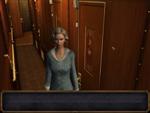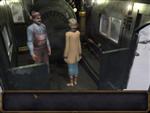Murder On The Orient Express Review

| Developer: | AWE Games |
| Publisher: | The Adventure Company / JoWood |
| Genre: | Adventure |
| Platform: | PC |
| Official Site: | http://www.agathachristiegame.com/motoe/ |
| Release Date: | December 26th, 2006 (UK) |
| Reviewer: | Duncan Lawson (sinna01) |
|
|
|
It seems to be a good month for classic detective fiction making its way into new games. Last week I got to have a preview peek at the as-yet uninspired Sherlock Holmes: The Awakening, and now it's the turn of Agatha Christies little Belgian detective to get the digital makeover. This offering published by Dream Catcher Interactive and developed by AWE Games shares the essential problems that The Awakening has - that classic drawing room detective fiction doesn't lend itself particularly well to games.
Whatever shortcomings the game later presents, AWE certainly did not skimp on the production values. You can tell an adventure game is going to at least deliver your moneys worth when, in this day and age, it still comes on two disks. The production values in Orient Express are excellent, and I don't recall having played a better-looking point-n-click adventure game. The last Alone in the Dark comes close for attention to detail, but cheated as the animation was superimposed on pre-drawn backgrounds. The first few minutes of the game are actually fairly indicative of the game as a whole, as they are both crammed full of visual excellence and attention to detail, whilst not actually being a terribly good puzzle game.




For avid fans of the book or those who have simply harboured strange yearnings to be short, fat, pompous and Belgian, there is a disappointment. You will not be playing Hercule Poirot, but rather a female character that becomes his eyes, ears, and inventory when he twists his ankle and conveniently becomes immobile. Starting outside the train station in Damascus, the game looks like the Turkish Tourist Board could endorse it. Buildings are lovingly crafted, incidental tourists and street vendors are competently skinned and animated, and pretty much every item is rendered in detail by the same engine. This makes the game look fantastic, but unfortunately robs the adventure gamer of one of his longest standing allies - the non-rendered item. Since the days of Gabriel Knight the player has been relying on spotting the relevant item as it pixilated badly with the pre-drawn background and so announced itself nicely.
Game engines obviously moved on, but their placing of items that could be gathered invariably looked wrong, perhaps due to lighting, perhaps due to fractionally missed alignment. The first few minutes of this game will show that the attention to detail has been sufficient that without a return to classic mouse-sweeping tactics on every screen, interactive items can easily be overlooked. The station where you board the titular train is full of finely crafted mosaics, streaming afternoon sunbeams, and glinting marble. The designers also understood an important element in animation - do not make static screens. Scenes that are completely still look wrong, like a photograph, and need some movement to make it appear living. In nearly every set there is a sunbeam with dust lazily shifting within it, a curtain ruffling in the breeze, blurred scenery whizzing by, or later on snow falling beyond a window. This additional animation layer can be turned off, although the system demands saving is negligible, and it will severely impact the visual quality of the game. Considering the vast majority of the game will be spent inside a train only 5 carriages long, it is just as well the interiors are sumptuous.




The audio is similarly excellent, with every single word of dialogue recorded. The voice acting is well cast and varied, rather than sounding like three guys doing various impressions, and would last for hours and hours if it was all played at once. Here, however, we come to the stumbling point of the game. You very nearly do simply listen to hours of it back to back, and this game comes perilously close to the odd genre of Interactive Fiction. The puzzle parts of the game are traditional point-n-click, such as finding the teeth to get the hammer to open the box to get the snowshoes, etc. These puzzles are essentially non-context specific - which is to say that the game could just as well be set on Mars as the Orient Express. The parts of the game that are relevant to the genre, and I am genuinely sorry for using the pun, are on rails. After gathering the bit of paper, the curling tongs, the hat stand, etc., we then advance the plot by combining them to solve some mystery and talk to the bed bound Poirot. These conversations present themselves in the traditional multiple-answer format, but it turns out this is simply window dressing. None of the options make any difference, and in nearly all cases the player will have to keep clicking until every single one has been used. This becomes annoying, as the requirement for the player to actually click on an answer is totally extraneous and a cheap way of trying to make you feel involved. No one would build a CD player you had to press 'play' after every single track for the same reason.




This inevitable progression marks long sections of the game as well. The first chapter of the game is getting aboard the train, your progress illogically blocked in turn by each of your future companion travellers. One will have lost their umbrella and demands its return; another wants an example of pottery, so on. Your path is only blocked thanks to the illogical rules of the puzzles game - the concept of walking around them unthinkable. Each puzzle is linear, solved one at a time, in order. This routine becomes quickly depressingly familiar. The second chapter of the game is conducting interviews with the 18 or so clich�d inhabitants of the train. The overbearing American, the toothless but happy driver, the sociopath Austrian chef, the greasy Italian, the stiff upper lip Brit. I think if saloon car hosted a minstrel show at half time we could have offended just about everyone - ahh, the simpler days of Agatha Christie. Since 99% of the game takes place on a train, the interviews are a process of sweeping up the train cabin by cabin, talking indeterminably with each character. The fully recorded and competently acted dialogue is impressive, but it is still the same conversation 18 times, every time with the annoying faux conversational options. When you get to the end of the train, you will get the extra clue, and then turn around and do the whole process again. Having swept the whole train for a second time, you talk to the Belgian, who with the power of his omniscient moustache declares that you should go and conduct yet another sweep, because now - somehow - things are different. Sure enough, doors magically unlock, items appear for no appreciable reason, and characters will suddenly talk to you again.




It is actually nearly impossible to create a game with direction or plot without these scripted events. But considering the literary pedigree of the original material, the constricted environment, and the production values of this game, you would expect the game to play more logically and with less invisible restrictions.
My last criticism of this game has more to do with the subject matter than the production, really, but is worth considering. Agatha Christie books are not actually all that good. They are a fake, a fraud, and are inevitably only a long wind-up to the end d�nouement. Reading one you know that Poirot, or that tottering tweed-wrapped state of emergency Mrs Marple, are not going to learn any life lessons or undergo character development. Nothing is going to befall them. They are going to walk around going 'Ah ha!' not explaining and possibly casting pitying looks at their bumbling assistant and by extension at you, the reader. Games should be fun whilst playing, should be engaging as you go along, and not just killing time until the boss battle. This game is one long and opaque run up to the whodunit revelation, which makes the gamer feel like they are just putting in time. If we were made to pay more attention by the conversation tree actually making a difference that might have involved us, but like the literary stooge, all we do is find pipes and combine random objects to make vinaigrette to placate the chef to�. Etc.
Summary
Agatha Christies Murder on the Orient Express looks absolutely gorgeous, and is probably the very pinnacle of the interactive-fiction genre. It is better compared to a books-on-tape product with great visuals than an actual game. Either the player is a fan of Christie and therefore the puzzles are a tedious and usually boringly linear interruption to the plot and dialogue, or the player is a dedicated gamer for whom the puzzles are too easy and the on-rails conversations far too long and frequent. I myself have not yet finished the game, but will continue to the end simply to see if the game really does just follow the plot of the book right to the end, because what would be the point of that? It would be a bit like making the game of The Usual Suspects, where after 20 hours of play you get to say, "Hey - so he was Kaiser Soze all along!".
Good stuff
- Some of the best graphics you will see in any adventure game.
- All the dialogue is acted, and not badly either.
- Very faithful to the style, if not always the plot, of the book.
- Low systems demands.
- Intuitive one-button control system.
Not so good stuff
- The game is (I am sorry, I know) on the rails.
- Dialogue options are pointless.
- Having the same conversation with 18 different characters.
- Interactive items sometimes obscure.
- No actual detective work to be done - just inventory kleptomania.
Things You Should Buy Just After You Move Into New House
Packers and Movers Chennai Are the Best At Such An Affordable Price
Guide For Packing Up The Master Bedroom In An Organized Way
Girls Are You Packing For College? Then You Need To Read These Tips First.